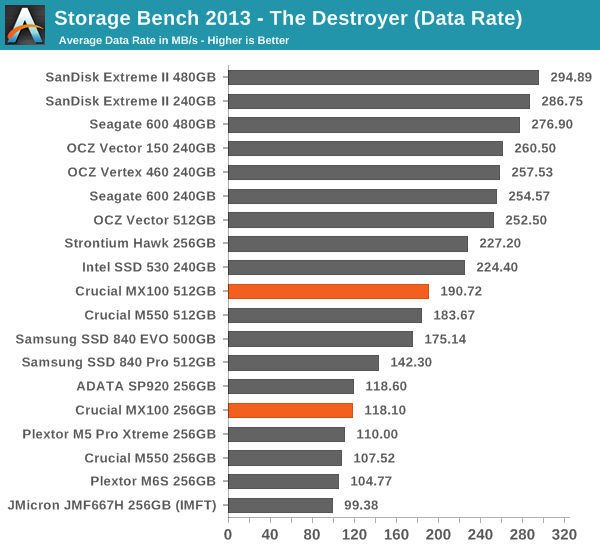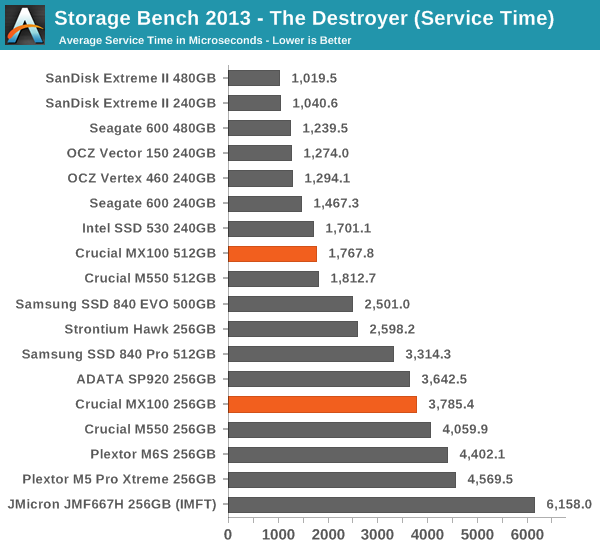Crucial MX100 (256GB & 512GB) Review
by Kristian Vättö on June 2, 2014 3:00 PM ESTAnandTech Storage Bench 2013
Our Storage Bench 2013 focuses on worst-case multitasking and IO consistency. Similar to our earlier Storage Benches, the test is still application trace based - we record all IO requests made to a test system and play them back on the drive we are testing and run statistical analysis on the drive's responses. There are 49.8 million IO operations in total with 1583.0GB of reads and 875.6GB of writes. I'm not including the full description of the test for better readability, so make sure to read our Storage Bench 2013 introduction for the full details.
| AnandTech Storage Bench 2013 - The Destroyer | ||
| Workload | Description | Applications Used |
| Photo Sync/Editing | Import images, edit, export | Adobe Photoshop CS6, Adobe Lightroom 4, Dropbox |
| Gaming | Download/install games, play games | Steam, Deus Ex, Skyrim, Starcraft 2, BioShock Infinite |
| Virtualization | Run/manage VM, use general apps inside VM | VirtualBox |
| General Productivity | Browse the web, manage local email, copy files, encrypt/decrypt files, backup system, download content, virus/malware scan | Chrome, IE10, Outlook, Windows 8, AxCrypt, uTorrent, AdAware |
| Video Playback | Copy and watch movies | Windows 8 |
| Application Development | Compile projects, check out code, download code samples | Visual Studio 2012 |
We are reporting two primary metrics with the Destroyer: average data rate in MB/s and average service time in microseconds. The former gives you an idea of the throughput of the drive during the time that it was running the test workload. This can be a very good indication of overall performance. What average data rate doesn't do a good job of is taking into account response time of very bursty (read: high queue depth) IO. By reporting average service time we heavily weigh latency for queued IOs. You'll note that this is a metric we have been reporting in our enterprise benchmarks for a while now. With the client tests maturing, the time was right for a little convergence.

Quite surprisingly, the MX100 is slightly faster than the M550 in our 2013 Storage Bench. The differences are not significant, but it's still surprising given that M550 is supposed to be Crucial's higher performing drive. Especially at 256GB this is odd because the M550 has lower capacity NAND that should result in more parallelism and thus more performance, but that doesn't seem to be that case. I'm guessing that Crucial has been able to tweak the firmware to unleash more performance from the Marvell 9189 controller, which would explain why the MX100 is faster than the M550. Then again, the ADATA SP920 with 128Gbit NAND and Micron designed firmware is also faster than the 256GB M550, so it looks like M550 doesn't take full advantage of the lower capacity NAND.











50 Comments
View All Comments
blanarahul - Monday, June 2, 2014 - link
Crucial sucks balls at making performance drives.. They should leave that market to Sandforce and Samsung, and concentrate on beating Samsung in value SSD market...hojnikb - Monday, June 2, 2014 - link
Sandforce makes performance drives ?!hahahah thats new :)
MrSpadge - Wednesday, June 4, 2014 - link
Please read the article.SmilingTornado - Thursday, June 5, 2014 - link
I am pretty sure this would be a "budget" SSD because of the $110 price tag and the fact that TigerDirect would be selling it for as little as $100 if you get a coupondanwat1234 - Monday, January 26, 2015 - link
No need for more performance than sandforce 2xxx, that pretty much eliminates the hard drive bottleneck completely for most uses in home computersEricZBA - Monday, June 2, 2014 - link
Already instock at Amazon. Sweet! http://www.amazon.com/Crucial-MX100-adapter-Intern...Hrel - Monday, June 2, 2014 - link
"Sequential Write 150MB/s 330MB/s"Why so slow? Especially when $100 drives get 550MB/s at 95k IOPS.
hojnikb - Monday, June 2, 2014 - link
Where do you have 100$ drive, that gets 550MB/ write ?!extide - Monday, June 2, 2014 - link
This is explained in the article... But it is because it uses fewer large capacity NAND dies to hit the low prices. For fast writed with NAND you need lots of dies, which is why the bigger versions of this drive see better performance.hojnikb - Monday, June 2, 2014 - link
And competitors are using nasty tricks like turbowrite or compression to achive such write speeds. But actual nand inside those mainstream drives isn't capable of such speeds.